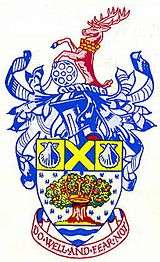Elstree Rural District
| Barnet Rural District Elstree Rural District (after 1941) | |
|---|---|
| Area | |
| • 1911 | 10,820 acres (43.8 km2) |
| • 1974 | 8,339 acres (33.75 km2) |
| Population | |
| • 1901 | 4,154 |
| • 1971 | 33,586 |
| History | |
| • Created | 1894 |
| • Abolished | 1974 |
| • Succeeded by |
Barnet Urban District Hertsmere |
| Status | Rural district |
| • HQ | Council Offices, Shenley Road, Borehamwood |
| • Motto | Do well and fear not |
 | |
Elstree Rural District (until 1941 known as Barnet Rural District) was a rural district in Hertfordshire, England from 1894 to 1974.
It was formed under the Local Government Act 1894 as Barnet Rural District,[1] as successor to the Barnet rural sanitary district. The rural district had an identical area to Barnet RSD except for the parish of South Mimms in Middlesex which went to form a single-parish South Mimms Rural District.
The district was renamed Elstree Rural District in 1941.[2] It was abolished in 1974, and merged with other districts to form the non-metropolitan district of Hertsmere.
Civil parishes
Over its existence the rural district consisted of the following civil parishes:[3]
| Parish | From | To | Notes |
|---|---|---|---|
| Arkley | 1894 | 1905 | Transferred to Barnet Urban District |
| Elstree | 1894 | 1974 | |
| Ridge | 1894 | 1974 | |
| Shenley | 1894 | 1974 | |
| Totteridge | 1894 | 1914 | Transferred to Barnet Urban District |
Arkley was formed from the rural part of the parish of Chipping Barnet in 1894. Totteridge constituted an exclave.[4] Arkley became part of the Barnet Urban District in 1905, and was joined there by Totteridge in 1914.
In 1935 a county review order amended the area of the district with 1,176 acres of Elstree, Ridge and Shenley transferred to Barnet Urban District; 392 acres of Ridge and Shenley transferred to St Albans Rural District; and 692 acres of Aldenham gained from Watford Rural District.
Coat of arms
On 20 March 1957, Armorial Bearings were granted. The arms and crest are described as follows:
- The background of royal ermine, represents the royal visits to and associations with the district, principally the visit of Henry VIII and his court to Tyttenhanger in 1525 to avoid the "sweatinge sicknesse" and the visits of Charles II to Salisbury Hall in Shenley. The oak tree with the Saxon crown represents Saxon Elstree – "Tidwulf's tree" – around which the district has grown. The tree also represents Boreham Wood and the district's woodlands, the gold acorns symbolize growth and prosperity. The waves at the base represent the River Colne, Aldenham Reservoir and link with the waves in the arms of the Hertfordshire CC and the Greater London Council.The gold saltire on blue is from the arms of the Abbey of St. Albans, the manor of Elstree came into the possession of the Abbey in 1188, and Tyttenhanger in Ridge stands on the site of a former possession of the Abbey, and the whole area lies in the Liberty of St. Albans. The scallop shells, the badge of pilgrims, recalls their passage along Watling Street through Elstree to St. Albans. The hart is from one of the supporters of the County Council arms, wearing a mural crown, symbol of civic government. The spool of film (unique in civic heraldry) recalls the industry which had made the name of Elstree and Boreham Wood so widely known in modern times. The motto is taken from the wall of Shenley Cage, and also links with the County motto "Trust and fear not".[5]
References
- ↑ Vision of Britain - Barnet RD
- ↑ Vision of Britain - Elstree RD
- ↑ Frederic A Youngs Jr., Guide to the Local Administrative Units of England, London 1979
- ↑ Vision of Britain - Barnet RD boundaries (exclave shown)
- ↑ "Elstree Rural District Council", Civic Heraldry of England and Wales. Retrieved 25 September 2011
Coordinates: 51°40′N 00°15′W / 51.667°N 0.250°W